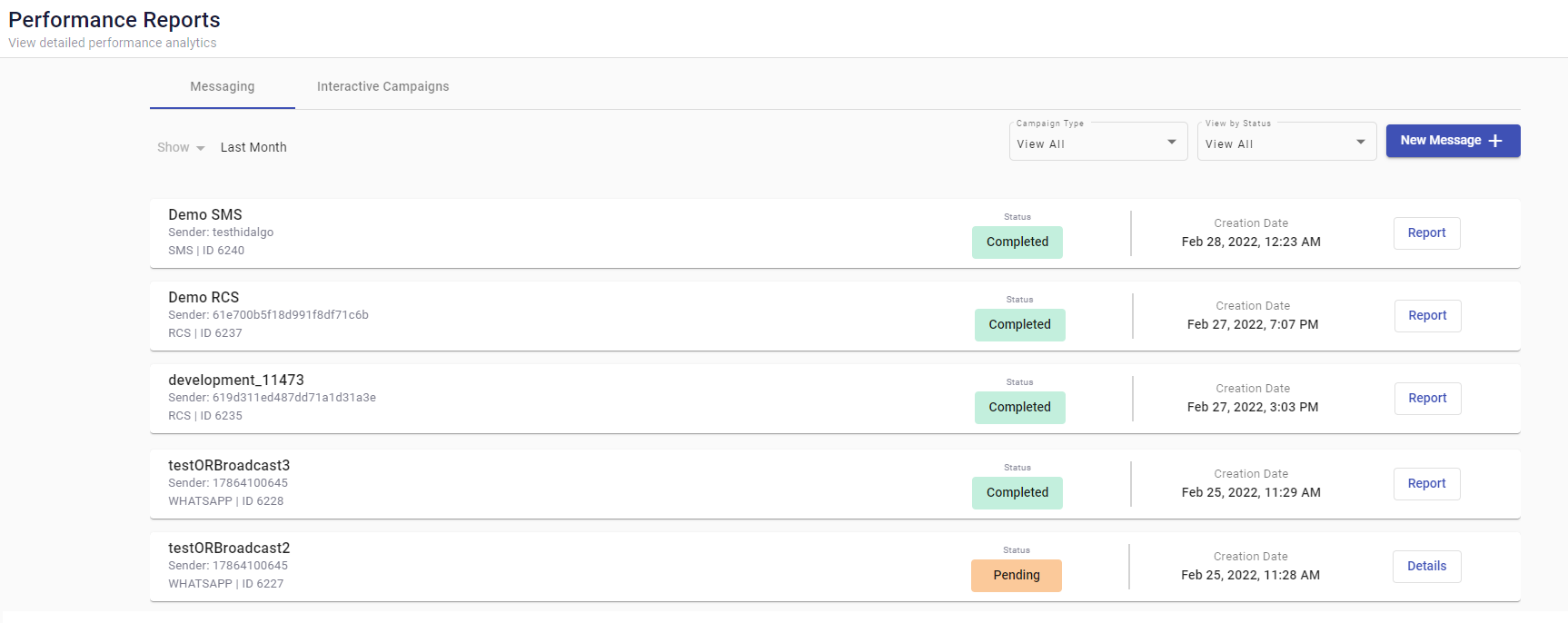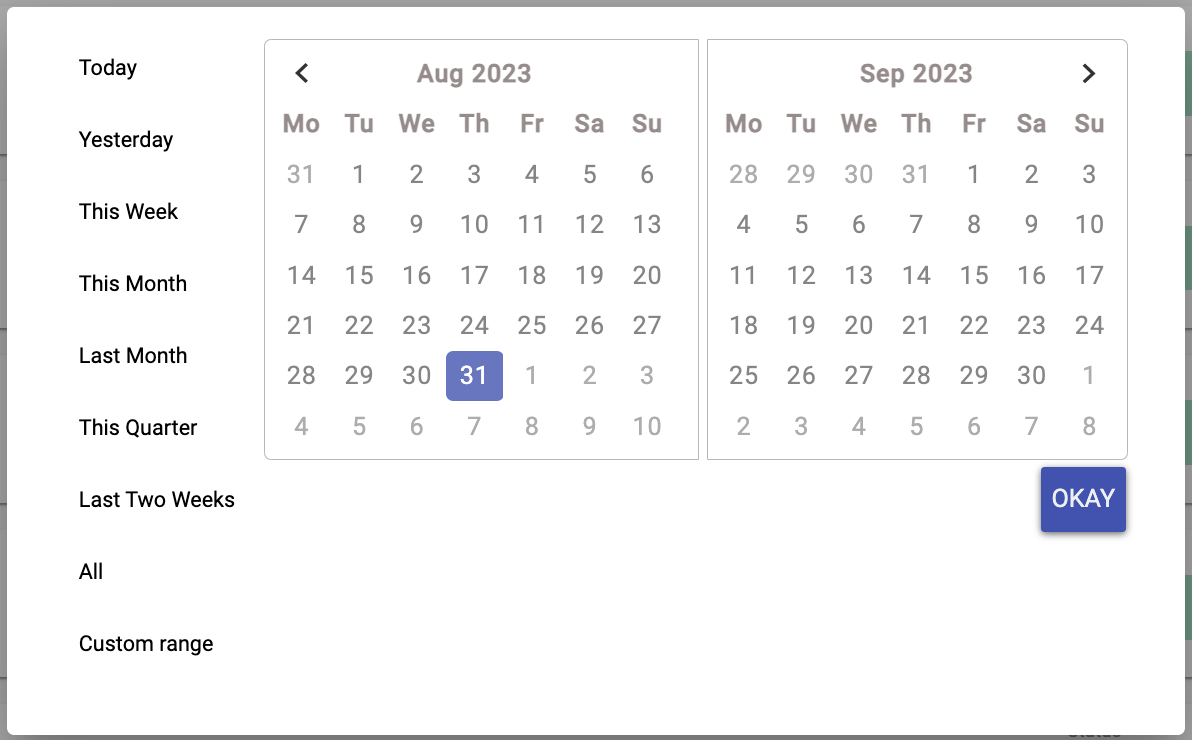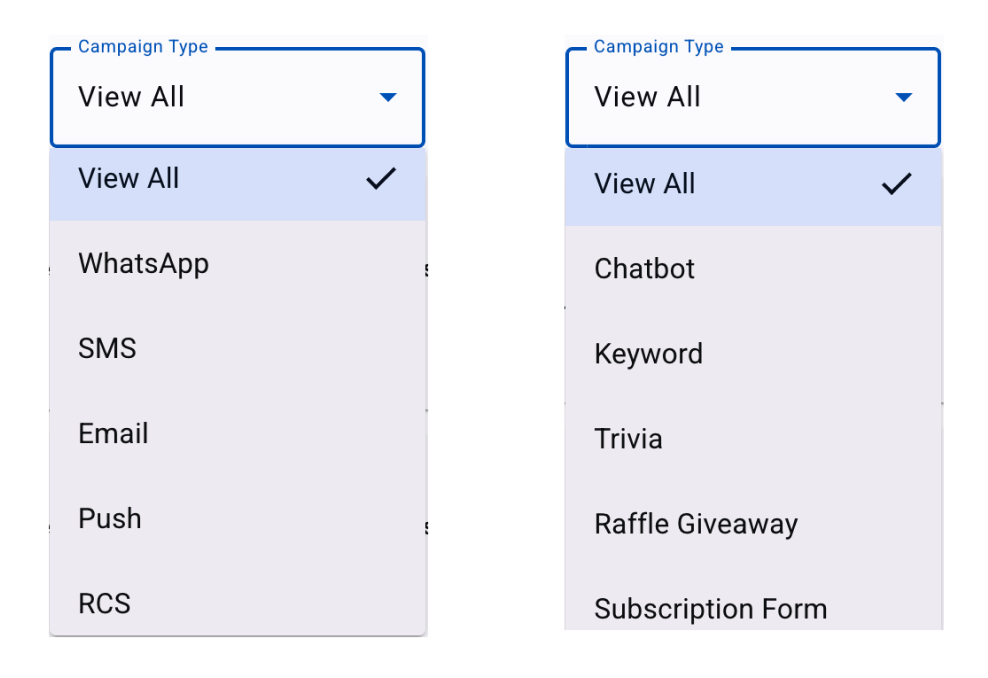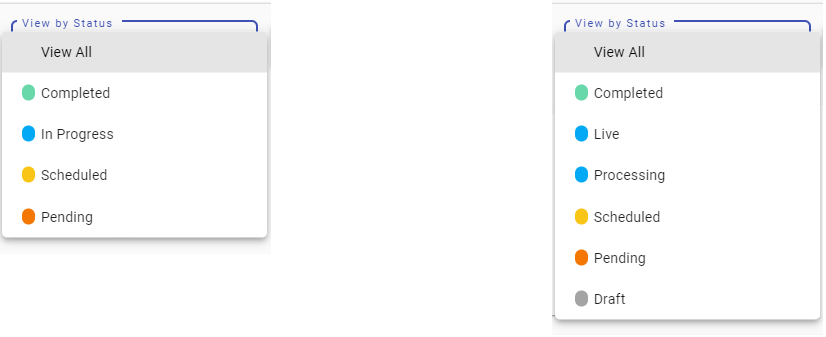Campaign Performance Reports
In Performance Reports, multiple aspects of the campaigns are addressed. But most importantly, it covers the campaign's results as well as their statuses.
The Platform gathers engagement data that can help you better understand how your audience uses and reacts to your apps and messages. Use the Platform’s Performance Analytics and Real-Time Data collection to interpret that data and learn how to best interact with your users.
The platform provides access to engagement data via:
-
Dashboard Reports: Reports for each message delivered. It provides flexible and interactive dashboards with clear performance views and easy customization. Navigation is intuitive and familiar, accessed from within the main Dashboard interface using drop-down menus and tabs.
-
Performance Analytics : Provides access to reports and graphs based on engagement data. Displays engagement data, helping you understand what your customers are doing and which behaviors cause them to take action. Furthermore, take action on KPIs using the Analytics Hub, time charts, breakdowns, and dashboards.
You access the Performance Reports section through its icon on the Navigation sidebar on the left as shown in the following figure.

It is divided into two tabs, one for each group of campaign types, Messaging and Interactive Campaigns. Each tab offers filters, the possibility to create new campaigns, and displays campaign cards in the main section of the pane.

Filters
Each tab offers three filters:
- Date Range Filter
- Campaign Type
- View by Status
Each of the filters works in the context of the tab in which they are offered and can be used together to get to specific campaigns for a specific date range, type, and status.
Date Range Filter
This is the general Date Range Filter offered throughout the platform that allows you to narrow down the display to specific dates.
The Show Date Range Filter is used in multiple sections of the UI, and in all instances, it is used with the same purpose, to filter the displayed data in the section to the selected date range. Only data generated within the selected range in the Show filter will be displayed.
Selecting it yields several predefined date range options and a two-month calendar, as shown in the following figure.

Narrow down the data to be displayed in any given section of the UI by selecting either one of the eight predefined options, selecting all records since the beginning of time or selecting from the calendar a custom range by choosing the start and end dates that you are interested in and and clicking on OKAY. The result will display only the information that was generated within the selected date range.
NOTESelecting the "All" option will display every record from the beginning of time to the current date. This option is only available when filtering by Messaging or Interactive Campaigns.
Campaign Types
Campaign Type is a context-dependent filter that displays the types of campaigns associated with each tab, as shown in the following figure with Campaign Types for the Messaging tab on the left and for Interactive Campaigns on the right.

View by Status
The filter View by Status is also a context-dependent filter with similar behavior as the Campaign Type filter, as it displays the possible states that a campaign can be in, depending on whether it’s a Messaging campaign or an Interactive Campaign. The image below shows the possible states that campaigns can be found in, with Messaging campaigns on the left and Interactive Campaigns on the right.

Messaging campaign Status
As it was shown before, depending on where a Messaging (SMS, Email, Push Notifications, WhatsApp, RCS) campaign is, in relationship to the delivery process, it can be in any of these four states:
-
Completed - Indicate that all Messages to be sent have been submitted to the Delivery Carrier.
Once a Messaging campaign has been completed, you can view the delivery metrics and analytics by selecting Report on the right side of the campaign card.
-
In Progress - Indicate that Messages are in the process of being sent.
The In Progress status will be displayed in real-time during the submittal of the Messaging campaign and will remain in this state until all the messages of the campaign are sent.
-
Scheduled - Indicate that their delivery has been specified for a future date
Clicking on Details of the Scheduled Messaging campaigns card will result in a redirect to the Details window for this campaign, where you can change its Scheduled Delivery Date or delete it.
-
Pending - Indicate that it does not have a set delivery date.
Clicking on Details of the Pending campaign card will result in a redirect to the Details window where you can change its Pending status or delete it.
These States are reflected on the Messaging Campaign Cards as shown in the example below.

Campaign Card Elements
Using the figure that follows as a guide, each card is organized, from left to right:

On the left end of the card,
- name given to the campaign: test
- platform sending entity: 61e9bb8f4a01ea313002dc2d
- campaign type: RCS and
- platform generated campaign ID: 6023
In the middle section of the card,
- Color Coded Campaign Status: Completed
- Creation Date: and time: Feb 9, 2022, 1:07 PM
On the far right of the card, one of two actions that can be taken on the campaign, according to its status. For this example,
- Action: Report
The other possibility offered by the campaign cards is to review the Details of a campaign, which applies to all campaigns except for Completed campaigns. The information revealed under the Details action varies according to the current status of the campaign.
Messaging Campaign Reports
Only Messaging campaigns that are in the Completed state will give access to the campaign Report section. Select from the following list to view the details of each messaging campaign report.
Interactive Campaign Status
There are six States that an Interactive Campaign can be in. Through View by Status, you can select any of the possible states, and the platform will display only Interactive Campaigns in that state. Reiterating, they are:
- Completed - Completed campaigns are those whose participation has been closed.
- Live - Live campaigns are those that are active for participation and have not reached their end of life. Live campaigns offer access to interim reports and can be paused for modification.
PAUSING LIVE CAMPAIGNS
To make a change to a Live Campaign, it needs to be paused and edited. This is done inside the Report section. A paused campaign will be interrupted, so the moment to pause the campaign must be according to the scope and need of the change.
For the case of Campaign Combos, where several campaigns can be associated, the platform will alert what campaigns will have their state affected if a campaign is paused. After the paused campaign is brought back to a Live state, the platform will alert what other campaigns need to be have their states modified.\
- Processing - Campaigns in the Processing state are those that are in the stage of preparing and/or submitting the campaign details for its proper setup, and neither one of those steps has been fully completed.
- Scheduled - Scheduled campaigns are those whose deployment date has been set for a specific date in the future and can only be set in this state at the moment they are defined.
- Pending - Pending campaigns are those that have been paused after having been active. A Pending campaign state can only be reached from the Live state.
Within the Details section, it will display the statistics that have been gathered up to the moment of the campaign being paused. The statistics shown will be dependent on the type of campaign.NOTEDepending on the campaign selected, different types of metrics and details are offered in the Details section of each campaign.
- Draft - A campaign with a Draft status is a campaign that was saved at the end of the creation process as a draft, which is the only way a campaign can fall into that state.
These States are reflected on the Interactive Campaign Cards as shown in the example below.

As was the case for the messaging campaign cards, the interactive campaign card structure follows the same format.
Interactive Campaign Reports
The Interactive Campaigns Reports section provides a comprehensive overview of how your interactive campaigns are performing across the platform. These reports are designed to help you evaluate audience engagement, monitor participation, and gain insights into campaign effectiveness across various delivery channels like SMS, Email, Push Notifications, WhatsApp, and RCS.
Unlike the case of messaging reports, where the reports are based on the channel type, Interactive Campaign reports are made up of different elements that address the relevant information that the platform gathers for a given campaign.
Deleting Campaigns
The campaigns can only be deleted under specific conditions. Follow the guidelines below to understand when a campaign is eligible for deletion:
- Campaign Interactions: A campaign can only be deleted if no one has interacted with it. This means there must be no data (such as engagement metrics or responses) associated with the campaign. Once a campaign has interactions, it cannot be deleted.
- Campaign Status: Campaign status also plays a crucial role in determining if it can be deleted:
- Campaigns in “Draft” status can be deleted at any time, as long as they have not been activated or set to “Live.”
- Campaigns that are currently in “Live” status cannot be deleted.
- If a campaign was previously set to “Live” and then paused ("Pending status"), it still cannot be deleted, even if there are no interactions.
Summary:
- Draft Campaigns: Can be deleted at any time.
- Live Campaigns: Cannot be deleted, even if they are paused and have no interactions.
- Campaigns with Data: Any campaign with recorded interactions or data generated cannot be deleted.
Steps to Delete a Campaign
To delete a campaign, make sure it meets the eligibility requirements: it must be in "Draft" status and have no interactions or data associated with it.
In this example, we will go through the steps to delete a campaign:
-
Access the Reports Section: Navigate to the Performance Reports section and select the Interactive campaign tab, where all campaigns are listed.
-
Find a Draft Campaign: Look for a campaign with the status labeled as Draft. Draft campaigns are eligible for deletion, provided they have no interactions.
-
Open the Campaign Report: Once you’ve located a Draft campaign, click on the Details button located next to the campaign status. This will open the campaign details card and the campaign overview.

-
Delete the Campaign: In the campaign details view, locate and click the Trash icon to delete the campaign. This action will remove the campaign permanently, as long as it meets the deletion requirements.

Updated 3 months ago
